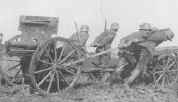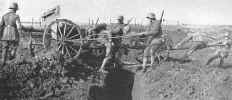
07-07-2009, 01:35 PM
|
 |
Administrator
|
|
|
|
 7.62cm Infanteriegeschütz L/16.5
7.62cm Infanteriegeschütz L/16.5
Calling this a Krupp gun is a misnomer of sorts, as it was originally a Russian artillery piece, captured in the war and then rebuilt by the German firm on instructions from the German Army. The original Russian gun was called the Putilov 76.2mm M/13, that started out as a Light Field Gun made by Schneider, and that was redesigned into an even lighter and simpler version, to be used mainly in fortresses and fortifications, for direct fire down into ditches and moats. (The Russian only used canister shot with this gun.) This is the reason for the strange fact that the depression capability of the gun far exceeded that of the elevation: -18°, as compared to only +11°. (They could be used for indirect fire as well, but this wasn't very easy or practical.) The German Army captured a lot of these guns during their successful campaigns in the East, and the light design of the piece impressed, som Krupp was ordered to redesign these captured specimens into an infantry gun. They kept the original barrel and breech, but attached a new wheeled carriage, a shield and two seats for the crew. Also, Rheinmetall designed a HE shell to be used with this gun, complementing the original Russian canister ammo, and extending the effective range up to some 4000 meters.
The whole gun could be broken down into smaller components, for ease in transport. It could be moved intact by a team of two horses, or broken down into two loads, and moved by one horse each. For shorter distances it was manhandled by the crew, as can be seen in the photo below.
The first 7.62cm Infanteriegeschütz L16.5 arrived at the front in the summer of 1916. They were attached to ad-hoc Assault units, units that eventually turned into the special elite Assault Batallions, that practised the new Stosstruppen-tactics, that soon were to prove soo sucessful, first on the Eastern Front, then in Italy, and finally in the West, during the huge German spring offensive in 1918. Every Assault batallion had a trench mortars, flame throwers and an Infantry Gun Battery attached. Every Infantry Gun Battery consisted of six of these Infanteriegeschütz L16.5. They were also used in a number of Independent Infantry Gun Batteries.
  The gun was a big success. In contrast with Heavy Artillery or even the ordinary 7.7cm Field Guns, these guns were always available, as they were under direct control of the troops - no need to go "durch Dienstwege", through proper channels, were request from Forward Observers could be lost or simply denied. The gun was also surprisingly accurate, and as it was only used for direct fire, it had not another drawback of heavier, indirect firing pieces: the risk of grenades falling short and hitting attacking troops was very small. The grenades were almost always bang on target, and it could be used in very close cooperation with the storm troopers. This accuracy made it possible to pinpoint enemy bunkers or MG:s, or simply keep them supressed until the moment the storm troopers made their final dash. This little gun didn't look much for the world, but it's total effect surpassed those of the few tanks that Imperial Germany could muster. The gun was a big success. In contrast with Heavy Artillery or even the ordinary 7.7cm Field Guns, these guns were always available, as they were under direct control of the troops - no need to go "durch Dienstwege", through proper channels, were request from Forward Observers could be lost or simply denied. The gun was also surprisingly accurate, and as it was only used for direct fire, it had not another drawback of heavier, indirect firing pieces: the risk of grenades falling short and hitting attacking troops was very small. The grenades were almost always bang on target, and it could be used in very close cooperation with the storm troopers. This accuracy made it possible to pinpoint enemy bunkers or MG:s, or simply keep them supressed until the moment the storm troopers made their final dash. This little gun didn't look much for the world, but it's total effect surpassed those of the few tanks that Imperial Germany could muster.
   But it had one drawback. It was weak in many points, structurally. There was a lot of breakage in the wheels, lavette and axle, and also the gun tubes wore out much more quickly than in german guns - the russian steel proved to be of low quality - which then led to a greatly reduced accuracy. This led to guns needing replacemnt, in some cases whole batteries receiving new equipment, often in the form of the 7.7cm Infanteriegeschütz L/20, which was a true Krupp gun. Still: most units used their original guns right up to the end of the war. But it had one drawback. It was weak in many points, structurally. There was a lot of breakage in the wheels, lavette and axle, and also the gun tubes wore out much more quickly than in german guns - the russian steel proved to be of low quality - which then led to a greatly reduced accuracy. This led to guns needing replacemnt, in some cases whole batteries receiving new equipment, often in the form of the 7.7cm Infanteriegeschütz L/20, which was a true Krupp gun. Still: most units used their original guns right up to the end of the war.
  
Calibre | 76.2 mm | Weight of Gun (emplaced) | 608 kilos | Maximum Range | HE: 4 kilometers
Canister: 600 meters | Muzzle Velocity | 295 metres per second | Min/Max Elevation | -18/+11 º | Weight of Shell | 6 kilos |


|






 The gun was a big success. In contrast with Heavy Artillery or even the ordinary 7.7cm Field Guns, these guns were always available, as they were under direct control of the troops - no need to go "durch Dienstwege", through proper channels, were request from Forward Observers could be lost or simply denied. The gun was also surprisingly accurate, and as it was only used for direct fire, it had not another drawback of heavier, indirect firing pieces: the risk of grenades falling short and hitting attacking troops was very small. The grenades were almost always bang on target, and it could be used in very close cooperation with the storm troopers. This accuracy made it possible to pinpoint enemy bunkers or MG:s, or simply keep them supressed until the moment the storm troopers made their final dash. This little gun didn't look much for the world, but it's total effect surpassed those of the few tanks that Imperial Germany could muster.
The gun was a big success. In contrast with Heavy Artillery or even the ordinary 7.7cm Field Guns, these guns were always available, as they were under direct control of the troops - no need to go "durch Dienstwege", through proper channels, were request from Forward Observers could be lost or simply denied. The gun was also surprisingly accurate, and as it was only used for direct fire, it had not another drawback of heavier, indirect firing pieces: the risk of grenades falling short and hitting attacking troops was very small. The grenades were almost always bang on target, and it could be used in very close cooperation with the storm troopers. This accuracy made it possible to pinpoint enemy bunkers or MG:s, or simply keep them supressed until the moment the storm troopers made their final dash. This little gun didn't look much for the world, but it's total effect surpassed those of the few tanks that Imperial Germany could muster. 

 But it had one drawback. It was weak in many points, structurally. There was a lot of breakage in the wheels, lavette and axle, and also the gun tubes wore out much more quickly than in german guns - the russian steel proved to be of low quality - which then led to a greatly reduced accuracy. This led to guns needing replacemnt, in some cases whole batteries receiving new equipment, often in the form of the 7.7cm Infanteriegeschütz L/20, which was a true Krupp gun. Still: most units used their original guns right up to the end of the war.
But it had one drawback. It was weak in many points, structurally. There was a lot of breakage in the wheels, lavette and axle, and also the gun tubes wore out much more quickly than in german guns - the russian steel proved to be of low quality - which then led to a greatly reduced accuracy. This led to guns needing replacemnt, in some cases whole batteries receiving new equipment, often in the form of the 7.7cm Infanteriegeschütz L/20, which was a true Krupp gun. Still: most units used their original guns right up to the end of the war.



 Similar Threads
Similar Threads

